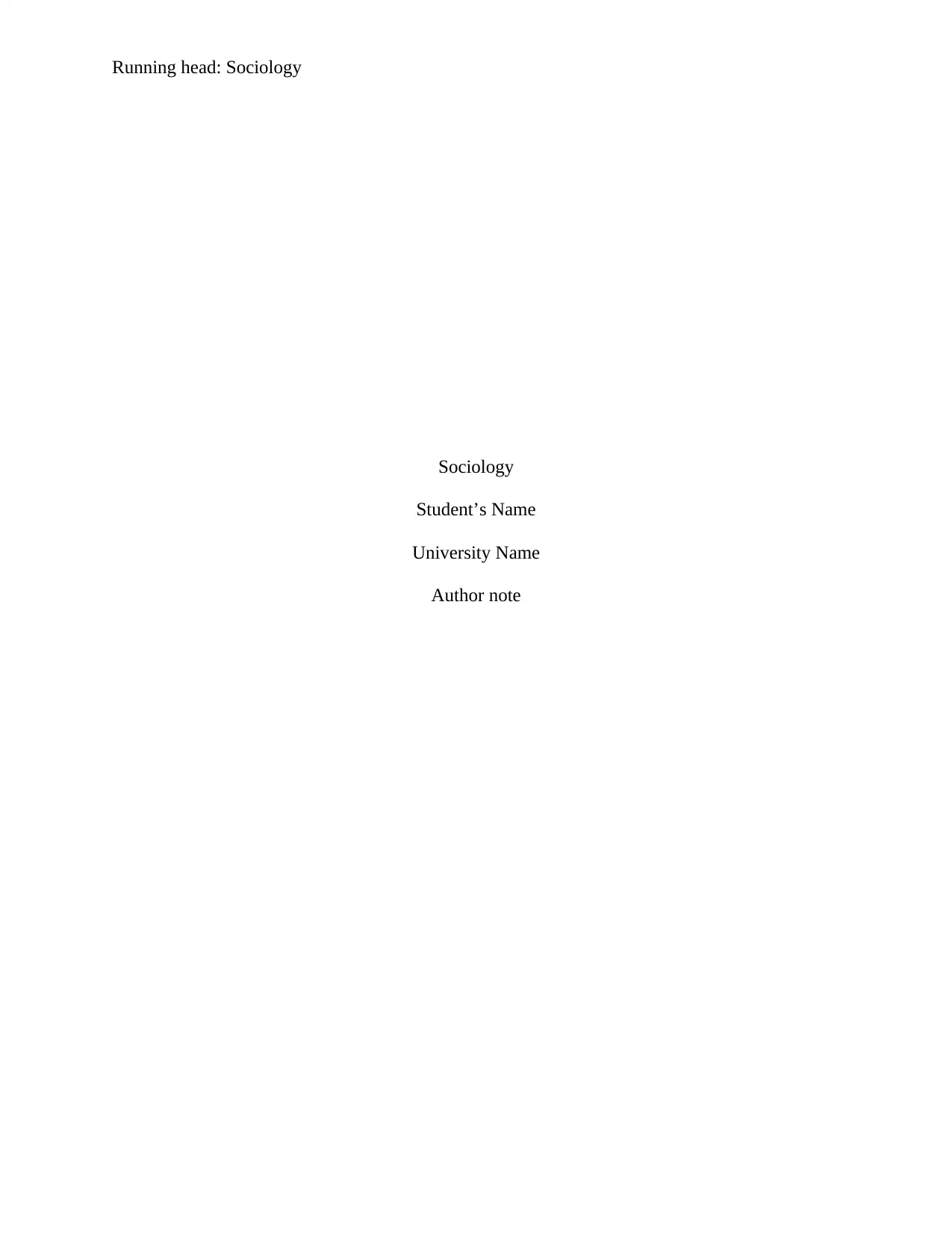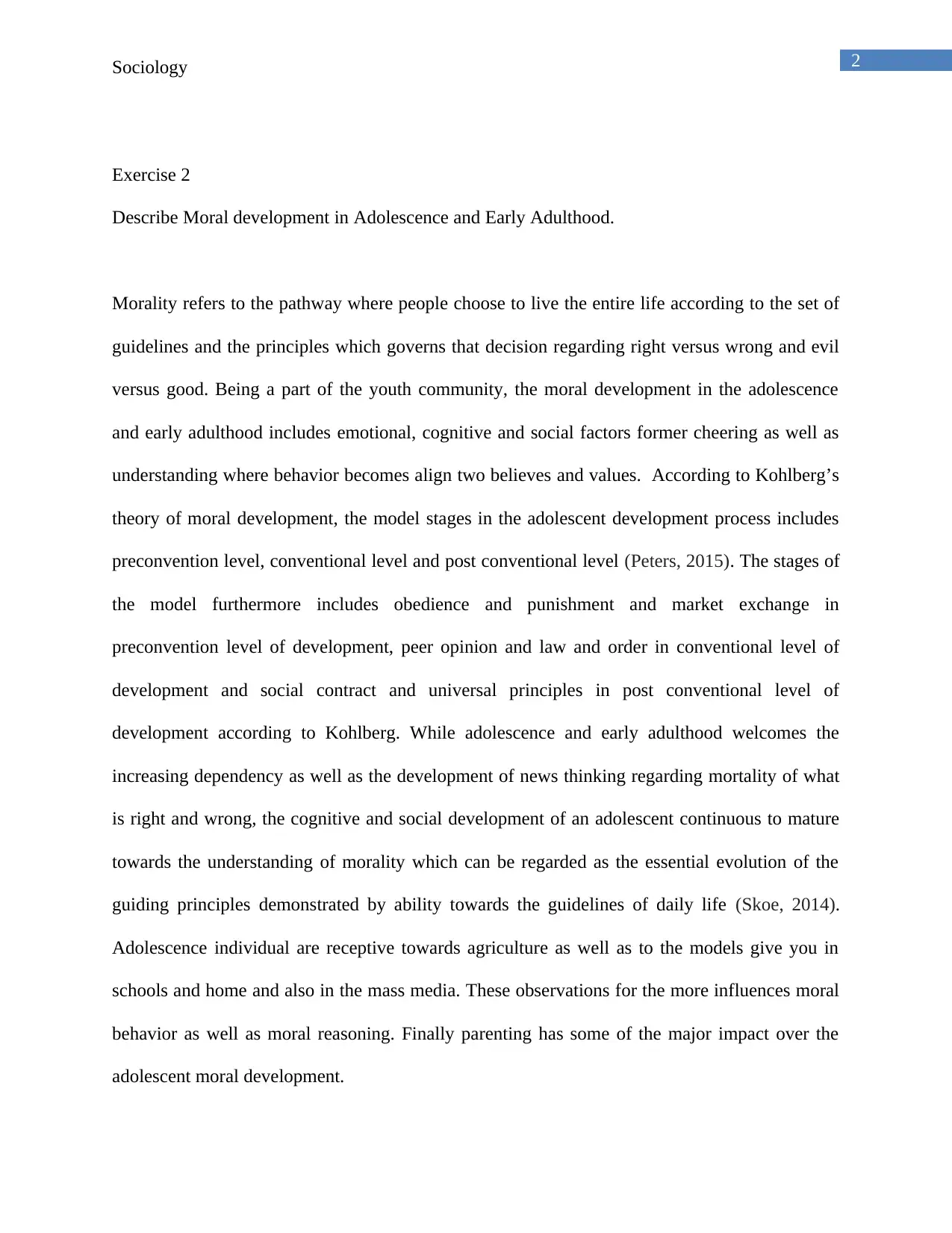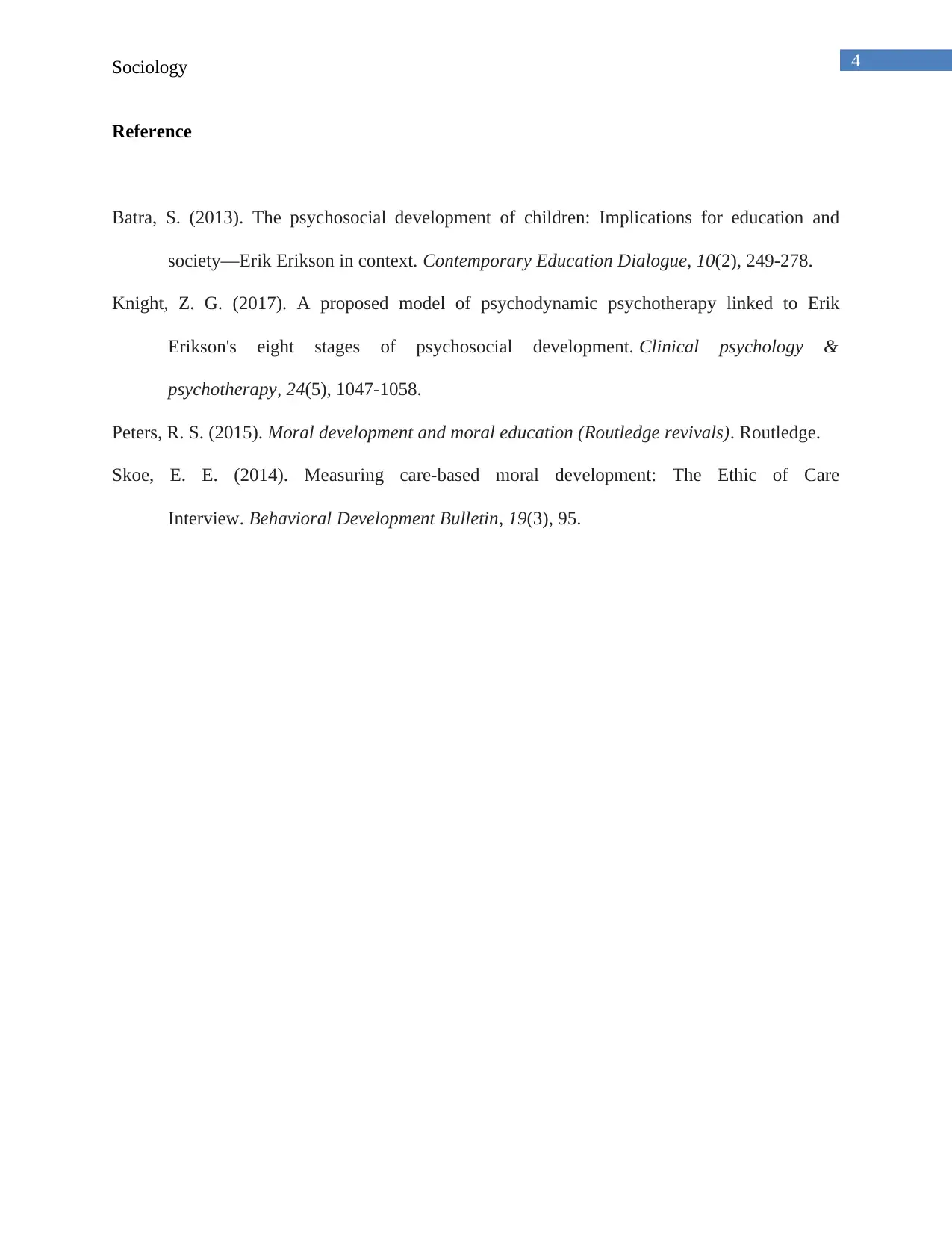Sociology 2: Erikson's Theory and Moral Development in Adolescence
VerifiedAdded on 2022/08/18
|5
|732
|27
Homework Assignment
AI Summary
This sociology assignment analyzes identity development and role confusion in adolescence through the lens of Erikson's psychosocial development theory. It details how adolescents navigate this stage, exploring independence and self-discovery. The assignment also examines moral development in adolescence and early adulthood, discussing Kohlberg's theory and its stages (preconventional, conventional, and postconventional levels). It emphasizes the influence of cognitive, emotional, and social factors on moral reasoning, as well as the impact of societal trends, social groups, and parenting on shaping moral behavior. The paper references key studies and models to provide a comprehensive understanding of the subject matter.

Running head: Sociology
Sociology
Student’s Name
University Name
Author note
Sociology
Student’s Name
University Name
Author note
Paraphrase This Document
Need a fresh take? Get an instant paraphrase of this document with our AI Paraphraser

1Sociology
Exercise 1
Describe identity development and role confusion in Adolescence period through the guidance of
Erikson's psychosocial development theory.
Identity development and role confusion among adolescence period within the Erikson
psychosocial development theory is the fifth stage of ego as per the psychologist’s norm.
According to this theory this stage occurs during the adolescence period among the age between
12 and 18. Adolescence explode there independence as well as initiate in the development of a
sense of the self during this stage as highlighted in the theory of psychosocial development. As
per Erikson, human being progress through a wide series of stages while growing and changing
throughout their entire life. During each of these stages, individual phases developmental conflict
which needs to be resolved for successful development of the primary virtue of that stage
(Knight, 2017). Erikson was interested in how relationships and social interactions impact the
growth and development. Towards the discussion of the development during the adolescent
years, the model highlighted the behavior of teens which often seems to be impulsive and
unpredictable but as a part of the process of finding a specific sense of personal identity. Family
members as well as parents continues to exert and important influence over the feelings of teams
in this adolescence stage. According to the psychosocial model societal trends and social groups
together with culture plays an important role towards forming and shaping identity (Batra, 2013).
Adolescence faces identity crisis and role confusion during the stage which specifically target
towards the development of the sense of being self. In this stage the adolescence try on several
different factors to explode the several roles as well as ideas in the attempt to discover their adult
selves.
Exercise 1
Describe identity development and role confusion in Adolescence period through the guidance of
Erikson's psychosocial development theory.
Identity development and role confusion among adolescence period within the Erikson
psychosocial development theory is the fifth stage of ego as per the psychologist’s norm.
According to this theory this stage occurs during the adolescence period among the age between
12 and 18. Adolescence explode there independence as well as initiate in the development of a
sense of the self during this stage as highlighted in the theory of psychosocial development. As
per Erikson, human being progress through a wide series of stages while growing and changing
throughout their entire life. During each of these stages, individual phases developmental conflict
which needs to be resolved for successful development of the primary virtue of that stage
(Knight, 2017). Erikson was interested in how relationships and social interactions impact the
growth and development. Towards the discussion of the development during the adolescent
years, the model highlighted the behavior of teens which often seems to be impulsive and
unpredictable but as a part of the process of finding a specific sense of personal identity. Family
members as well as parents continues to exert and important influence over the feelings of teams
in this adolescence stage. According to the psychosocial model societal trends and social groups
together with culture plays an important role towards forming and shaping identity (Batra, 2013).
Adolescence faces identity crisis and role confusion during the stage which specifically target
towards the development of the sense of being self. In this stage the adolescence try on several
different factors to explode the several roles as well as ideas in the attempt to discover their adult
selves.

2Sociology
Exercise 2
Describe Moral development in Adolescence and Early Adulthood.
Morality refers to the pathway where people choose to live the entire life according to the set of
guidelines and the principles which governs that decision regarding right versus wrong and evil
versus good. Being a part of the youth community, the moral development in the adolescence
and early adulthood includes emotional, cognitive and social factors former cheering as well as
understanding where behavior becomes align two believes and values. According to Kohlberg’s
theory of moral development, the model stages in the adolescent development process includes
preconvention level, conventional level and post conventional level (Peters, 2015). The stages of
the model furthermore includes obedience and punishment and market exchange in
preconvention level of development, peer opinion and law and order in conventional level of
development and social contract and universal principles in post conventional level of
development according to Kohlberg. While adolescence and early adulthood welcomes the
increasing dependency as well as the development of news thinking regarding mortality of what
is right and wrong, the cognitive and social development of an adolescent continuous to mature
towards the understanding of morality which can be regarded as the essential evolution of the
guiding principles demonstrated by ability towards the guidelines of daily life (Skoe, 2014).
Adolescence individual are receptive towards agriculture as well as to the models give you in
schools and home and also in the mass media. These observations for the more influences moral
behavior as well as moral reasoning. Finally parenting has some of the major impact over the
adolescent moral development.
Exercise 2
Describe Moral development in Adolescence and Early Adulthood.
Morality refers to the pathway where people choose to live the entire life according to the set of
guidelines and the principles which governs that decision regarding right versus wrong and evil
versus good. Being a part of the youth community, the moral development in the adolescence
and early adulthood includes emotional, cognitive and social factors former cheering as well as
understanding where behavior becomes align two believes and values. According to Kohlberg’s
theory of moral development, the model stages in the adolescent development process includes
preconvention level, conventional level and post conventional level (Peters, 2015). The stages of
the model furthermore includes obedience and punishment and market exchange in
preconvention level of development, peer opinion and law and order in conventional level of
development and social contract and universal principles in post conventional level of
development according to Kohlberg. While adolescence and early adulthood welcomes the
increasing dependency as well as the development of news thinking regarding mortality of what
is right and wrong, the cognitive and social development of an adolescent continuous to mature
towards the understanding of morality which can be regarded as the essential evolution of the
guiding principles demonstrated by ability towards the guidelines of daily life (Skoe, 2014).
Adolescence individual are receptive towards agriculture as well as to the models give you in
schools and home and also in the mass media. These observations for the more influences moral
behavior as well as moral reasoning. Finally parenting has some of the major impact over the
adolescent moral development.
⊘ This is a preview!⊘
Do you want full access?
Subscribe today to unlock all pages.

Trusted by 1+ million students worldwide

3Sociology
Paraphrase This Document
Need a fresh take? Get an instant paraphrase of this document with our AI Paraphraser

4Sociology
Reference
Batra, S. (2013). The psychosocial development of children: Implications for education and
society—Erik Erikson in context. Contemporary Education Dialogue, 10(2), 249-278.
Knight, Z. G. (2017). A proposed model of psychodynamic psychotherapy linked to Erik
Erikson's eight stages of psychosocial development. Clinical psychology &
psychotherapy, 24(5), 1047-1058.
Peters, R. S. (2015). Moral development and moral education (Routledge revivals). Routledge.
Skoe, E. E. (2014). Measuring care-based moral development: The Ethic of Care
Interview. Behavioral Development Bulletin, 19(3), 95.
Reference
Batra, S. (2013). The psychosocial development of children: Implications for education and
society—Erik Erikson in context. Contemporary Education Dialogue, 10(2), 249-278.
Knight, Z. G. (2017). A proposed model of psychodynamic psychotherapy linked to Erik
Erikson's eight stages of psychosocial development. Clinical psychology &
psychotherapy, 24(5), 1047-1058.
Peters, R. S. (2015). Moral development and moral education (Routledge revivals). Routledge.
Skoe, E. E. (2014). Measuring care-based moral development: The Ethic of Care
Interview. Behavioral Development Bulletin, 19(3), 95.
1 out of 5
Related Documents
Your All-in-One AI-Powered Toolkit for Academic Success.
+13062052269
info@desklib.com
Available 24*7 on WhatsApp / Email
![[object Object]](/_next/static/media/star-bottom.7253800d.svg)
Unlock your academic potential
Copyright © 2020–2025 A2Z Services. All Rights Reserved. Developed and managed by ZUCOL.





